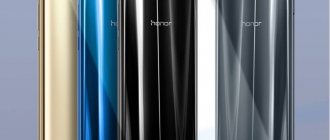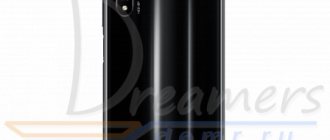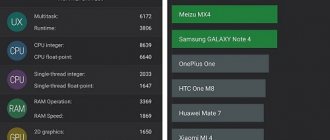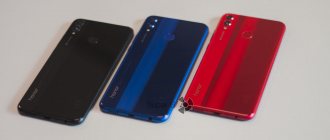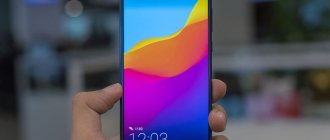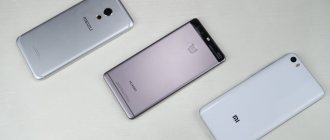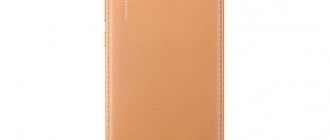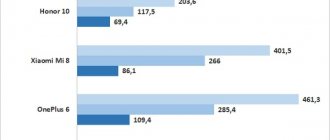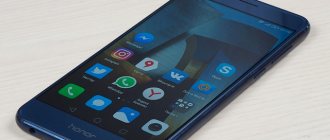Honor and Huawei: where to look for differences?
Honor organization manager George Zhao explains that the differences between these organizations primarily lie in the distribution and promotion of smartphones. If we compare them, it is Honor that receives more attention from young users. This brand has helped Huawei expand its customer base.
Honor phones are advancing thanks to the use of new technologies and methods of communication. Devices of this brand are massively sold through virtual stores.
The rating of Huawei and Honor smartphones gives you the opportunity to compare budget, mid-segment and flagship devices. And after comparison we can already conclude which is better.
You can see the distinctive features of smartphones in the following video:
Which smartphone is better: Honor or Huawei (and what is the difference)?
If you have already noticed some similarities between the phones of the two Chinese brands, you will hardly be very surprised that Honor is a subsidiary brand of the Chinese company Huawei, created in 2013. Accordingly, in technical terms, the models of both brands are almost identical, but there is also a reasonable grain in this division. The Honor brand (“Honor” or “Honor”) was not registered by chance.
► Honor and Huawei have different target audiences: Honor smartphones are created for a younger audience and are sold mainly in online stores. This allows you to reduce the cost of the device and reduces the costs of transportation and warehousing.
► Having two brands allows the company to better understand customers and collect feedback from both older customers and young people. Thanks to this, Huawei and Honor are among the few manufacturers that constantly offer their fans coveted new products.
It is important to note that the gadgets of both companies are equipped with the same hardware and components; the devices are even visually similar.
But there is still a slight difference between Honor and Huawei:
► Design.
Honor has a bright and attractive design; the most non-standard color solutions are traditionally used here. Huawei produces smartphones in a classic style with muted shades.
► Cost. Honor smartphones tend to cost a little less than Huawei. However, a lot here depends on the store and the specific device model.
CASHBACK 800 rub. on Wildberries!
From now on you will receive real cashback up to 800 rubles. on Wildberries when purchasing products from the list!
PRODUCTS WITH CASHBACK
Budget devices
When deciding whether to buy Huawei or Honor, you need to take into account that both smartphones have excellent characteristics and visually look expensive.
Honor 10 Lite
It is this device that amazes with the implementation of a full-screen format with small frames, due to this the diagonal of the space is 6.21 inches. The memory capacity shows the availability of 64 GB. And at the top of the display there is a small teardrop-shaped insert, while this innovation is typical of more expensive devices. A similar implementation is needed to increase the total space on the front panel.
In other respects, the 10 Lite smartphone is not inferior to its rivals, complemented by an internal charging capacity of 3400 mAh, several main shooting modules of 13 and 2 megapixels. There is also a front-facing lens with a resolution of 24 megapixels.
Huawei P Smart (2019)
The manufacturer recently released a new model for the P Smart line. The original smartphone was launched earlier in 2021, but the new version has more benefits. For example, the most innovative model of 2019 received a wide display with a diagonal of 6.21 inches, changing the previous 5.7-inch format.
It is difficult to find differences when comparing Huawei and Honor, because in terms of characteristics, the P Smart (2019) is somewhat similar to the 10 Lite model, but instead of a 24 MP front camera resolution, 8 MP is used, and the internal battery capacity is only 3000 mAh. But in fact, it cannot be guaranteed that such parameters can ensure good quality and long service life of the device, so a more comprehensive practical comparison is required.
Assembly - almost identical
It's not surprising for products from one company and its subsidiaries to have similar internal layouts. The drawings used to assemble devices, as well as companies’ design standards for smartphones, are subject to general rules that engineers follow. The first suspicions of self-copying arose at the stage of the legal separation of Honor from Huawei as an independent brand. And with the emergence of information about the separation of the Nova model into a separate brand, these rumors appeared again.
As an example of such similarity, we can cite Apple devices that are monotonous in terms of design and layout, which practically do not change internally from model to model, unless the dimensions of the components and the case change. And although the example does not quite fit the situation, since it deals with uniformity within one manufacturing company, it is nevertheless strange to expect something different in subsidiaries that have the same “head”.
And this is exactly the situation that occurs in Huawei, Honor and Nova devices - the layout schemes are almost identical, and the changes take into account only minor differences in components. Which is not surprising, provided that they have the same suppliers.
Middle segment
The best phones at the moment costing from 11,000 rubles:
- Huawei P Smart;
- Honor 9 Lite;
- Honor 7X.
Huawei P Smart
This model is one of the best in this segment. It stands out with an excellent dual-type camera of 13 and 2 megapixels, a huge 5.65-inch display and a 3,000 mAh battery.
Advantages of this device:
- metal body;
- dual type camera;
- decent high resolution screen;
- performance.
Disadvantages of a smartphone:
- poor autonomy;
- Low performance, cannot run powerful games.
Honor 9 Lite
Judging by the characteristics, the Honor phone fully justifies its price. It is equipped with a high-quality 5.65-inch screen and has excellent resolution; it also boasts a HiSilicon Kirin 659 processor and a dual main camera (13 and 2 megapixels).
Despite the decent price of the smartphone, it is called a simplified flagship. The weak 3,000 mAh battery thickens things a bit.
Honor 7X
For the average group, the smartphone's nearly 6-inch display looks great. But this is not all the advantages contained in the device.
The main camera has two modules of 16 and 2 megapixels. The memory is 4 GB, and the battery capacity is 3,340 mAh. The advantages include the beautiful design of the device. Simply put, almost all capabilities are provided to the modern user.
The downside is the lack of NFC fast charging.
The history of Huawei
The history of the flagship is inextricably linked with the sub-brand. They are considered together. Let's start with the main company Huawei:
- a popular company from China dealt with parts, hardware and software for devices;
- since 2010, the flagship has introduced mobile devices that are appreciated by users;
- in 2011, the company increased revenue by 500% compared to the initial sales level;
- the brand changed its tactics, identified a new target audience, clients in the middle money segment;
- after that it began to produce various premium devices, sometimes creating budget options.
How a fitness bracelet measures oxygen in the blood - instructions
Flagship segment comparison
To finally understand the differences between smartphones and leading manufacturers, you need to study the flagships and draw a conclusion.
Honor View 20
In real life, Honor View 20 is perceived as the best solution of the organization, while the predecessor was released in 2018 in January, and the difference is felt when compared with the new version, even without a full inspection. The main feature of the device is the use of a 6.4-inch diagonal screen.
Honor's hardware is represented by the Kirin 980 chip, which is also used in Huawei's flagship devices. There are no other amazing characteristics in the smartphone. The phone is equipped with a 48 megapixel main shooting module, which is used together with a 3D camera, while the identical parameters of the front sensor are 25 megapixels.
Huawei P20
This gadget has a screen diagonal of 5.8 inches. Such parameters may feel less important compared to other analogues, but in real life the dimensions of the P20 version are close to the dimensions of the iPhone XS.
The device is equipped with a very good Kirin 970 chip combined with 4 GB of memory, and on the back there is a block of 2 cameras. They consist of a main sensor and an additional sensor with a resolution of 12 megapixels and 20 megapixels, naturally providing excellent shooting quality.
The difference between Huawei and Honor as companies lies primarily in their separate existence, but in real life the devices are created using identical power and parts. But the subsidiary brand can make its own decisions regarding its products, and it also becomes better independently of Huawei.
Honor or Huawei: choosing the best smartphone from budget to premium
Over the past few years, Huawei has managed to seriously gain a foothold in the mobile industry and become a market leader. Around the same time, its Honor sub-brand became a separate brand. However, both are still part of the Huawei Consumer Business Group. Honor and Huawei target different consumer segments and offer a different set of products.
Honor and Huawei target different consumer segments and offer a different set of products. Our friends from Andronews provided us with comprehensive information on both brands and we decided to share it with our readers.
From the very beginning, Honor was conceived as a young, energetic and Internet-oriented brand, aimed at creating the best and most affordable mobile access to all Internet resources for the younger generation of users. At the same time, Huawei has a different strategy, targeting the business elite and premium segments, which is different from Honor's idea of targeting accessibility. The dual brand strategy provides Huawei with a competitive advantage in various market segments.
At first, Honor was known only as a sister brand to Huawei, but now it has come into the spotlight as something in its own right. Like Huawei, it has a range of smartphones at different price points, and just as Huawei competes successfully in the premium segment, Honor challenges the budget end of the market with enviable specs and, in many cases, beautiful designs.
Characteristics
If you try to compare the characteristics of devices from both brands, you will find that, despite the presence of some features, they have a lot in common. Budget phones from both brands, Honor and Huawei, are mainly equipped with IPS screens, while more expensive ones often use AMOLED panels. Huawei's own HiSilicon Kirin processors are used in devices from both brands, although in the future the company will apparently have to abandon them in favor of third-party chipsets. This is due to a new wave of trade sanctions against Huawei by the United States.
Both brands place an emphasis on cameras, although Huawei's camera kits certainly deliver better results. However, these smartphones are more expensive. At the same time, Honor phones are called “people's camera phones” - and deservedly so, since they demonstrate good image quality at an affordable price.
If we talk about build quality, it is logical that Huawei’s policy involves premium materials and higher quality, although they also have budget phones in plastic cases. The same can be said about Honor smartphones - this inexpensive brand, in addition to budget models, also has high-end devices of very high quality.
Thus, both sister brands have smartphones in different price and quality segments, which means the choice between Honor and Huawei is a matter of personal preference.
Up to 15,000 rubles
Huawei P40 Lite (about 15,000 rubles)
The budget origin of the Huawei P40 Lite model is revealed by the back cover of the case, made of plastic; otherwise, the smartphone looks solid for its price category. It has a fairly large 6.4-inch screen built into it with a neat cutout for the selfie camera. As for the hardware, on board you will find a fairly powerful Kirin 810 processor complete with 6 GB of RAM, which can perform well, including in games. This budget model has a quad camera, the main sensor of which has a resolution of 48 megapixels. The P40 Lite has a night mode, so you can take good pictures even in low light conditions. Among the advantages of the device, it is worth noting a capacious battery with support for fast charging.
If we talk about the disadvantages, you should keep in mind that the device’s camera does not have optical image stabilization, which is why the video is not of very high quality. In addition, Huawei P40 Lite supports memory cards of the internal Nano Memory standard, which can hardly be considered widespread.
Specifications of Huawei P40 Lite:
- Screen: 6.4″ IPS LCD display (1080 x 2310)
- SoC: HiSilicon Kirin 810
- RAM: 6 GB
- Internal memory: 64/128 GB, expandable via Nano Memory cards
- Main camera: 48 MP, f/1.8, Sony IMX586, ultra-wide-angle 8 MP, f/2.4, macro camera 2 MP, depth sensor 2 MP
- Front camera: 16 MP
- Battery: 4200 mAh, 40 W fast charging
- Software: Android 10.0
Honor 9C (about 10,500 rubles)
Huawei Honor 9C looks quite simple but stylish thanks to its large 6.39-inch punch-hole display. The smartphone camera is very good, for a budget line. Yes, it won’t provide you with great shots in low light, but the presence of an ultra-wide-angle lens will allow you to shoot beautiful landscapes - it’s not for nothing that this model is considered an affordable camera phone. The advantages include a battery of solid capacity, which ensures a day of battery life of the device in active mode, the presence of a separate slot for a microSD memory card and an NFC chip.
With such a low price, there are some downsides. The main ones are the low screen resolution, as well as the lack of support for fast charging and Google services.
Specifications of Huawei Honor 9C:
- Screen: 6.39 ", 1560x720 (19.5:9), LTPS
- SoC: HiSilicon Kirin 710A
- RAM: 4 GB
- Internal memory: 64 GB, expandable
- Main camera: 48 MP, f/1.8, ultra-wide-angle 8 MP, f/2.4, depth sensor 2 MP
- Front camera: 8 MP
- Battery: 4000 mAh
- Software: Android 10.0
Up to 20,000 rubles
Huawei Nova 3 (about 20,000 rubles)
Huawei Nova 3 cannot be classified as a new model, but at one time it occupied a niche in the upper middle segment, as a result of which it is still relevant today. It has a built-in high-performance Kirin 970 processor with a graphics co-processor that copes not only with everyday tasks, but also with running games with complex graphics. The device features a stylish design made of glass and metal, its body is made in gradient colors. The main camera of the smartphone, although not distinguished by a large number of megapixels, is capable of shooting video in 4K resolution. In addition, Huawei Nova 3 has not only a fingerprint scanner, but also facial recognition. Fans of high-quality sound will appreciate the 7-channel audio of this model.
Of course, there were some downsides. These include the lack of moisture protection, wireless charging, and the presence of a second SIM card slot, which serves as a memory card slot. Perhaps some users will consider not the most modern software as a disadvantage, since Huawei Nova 3 runs Android 9.0 OS and a dual camera system.
Specifications of Huawei Nova 3:
- Screen: 6.3″ IPS LCD display (1080 x 2340)
- SoC: HiSilicon Kirin 970
- RAM: 6 GB
- Internal memory: 64/128 GB, expandable via Nano Memory cards
- Main camera: 16 MP, f/1.8, 24 MP monochrome sensor
- Front camera: dual, main lens 24 MP
- Battery: 3750 mAh, with support for fast charging
- Software: Android 9.0, EMUI 9
Honor Note 10 (about 17,000 rubles)
Huawei Honor Note 10 looks very stylish thanks to its thin body, which, among other things, is well protected from impacts. A capacious 5000 mAh battery with fast charging support promises users a full day of active work. The large and bright Super AMOLED screen turns this smartphone almost into a phablet, but due to the thin frames the device looks elegant.
Honor Note 10 is equipped with a high-performance Kirin 970 processor, which was considered a flagship processor not so long ago, which means there are no problems with running games. The advantages of the device include sound with Dolby Atmos support, the presence of an audio jack and a slot for a microSD card. If we talk about the disadvantages, then there is the lack of an IP rating and a slippery case, which, due to its size, is not very convenient to use with one hand.
Specifications of Huawei Honor Note 10:
- Screen: 6.95 ", 2220x1080 (18.5:9), Super AMOLED
- SoC: Hisilicon Kirin 970
- RAM: 4 GB
- Internal memory: 64/128 GB, expandable via microSD slot
- Main camera: 16 MP, f/1.8, monochrome 24 MP
- Front camera: 13 MP
- Battery: 5000 mAh with 22.5W fast charging
- Software: Android 10.0
Up to 30,000 rubles
Huawei Nova 5T (about 23,000 rubles)
In its price category, the Huawei Nova 5T is a very good purchase. The smartphone comes with Google services on board and premium hardware, which includes a Kirin 980 processor complete with a large amount of RAM. The device's virtually frameless tap makes a great impression, and the quad camera is capable of taking versatile pictures in a wide range of lighting conditions.
The main 48MP camera module is Sony IMX586, the same one used in many premium devices, including the One Plus 7pro. This sensor is complemented by an ultra-wide-angle lens and a macro camera, as well as a depth sensor. The Huawei Nova 5T has a very solid front camera with a resolution of 32 megapixels. It is located in a compact screen slot. Fast charging allows you to charge a 3750 mAh battery to 50% in almost half an hour.
The disadvantages of the Nova 5T include the absence of an optical image stabilization system, an audio jack and stereo speakers.
Specifications of Huawei Nova 5T:
- Screen: 6.26 ", 2340×1080 (19.5:9), IPS
- SoC: HiSilicon Kirin 980
- RAM: 6 GB
- Internal memory: 128 GB, expandable via Nano Memory cards
- Main camera: 48 MP, f/1.8, ultra-wide-angle 16 MP, f/2.4, 2 MP macro camera, 2 MP depth sensor
- Front camera: 32 MP
- Battery: 3750 mAh, fast charging at 22.5 W
- Software: Android 9.0, EMUI 9
Honor 30S (about 25,500 rubles)
Huawei Honor 30S looks very attractive thanks to its elegant mirror body and high-quality contrast display with a diagonal of 6.5 inches, a resolution of 2400 x 1080 and HDR10 support. The fast Kirin 820 processor that controls the device is built on a three-cluster architecture, which ensures battery saving and high performance in games. It should be noted that there is a large amount of internal memory - at least 128 MB and an excellent set of cameras with a 64 MP main sensor and three times optical zoom. The fast charging system is impressively fast, allowing your smartphone to charge up to 70 percent in just half an hour.
The disadvantages include the presence of a slot for cards of its own Nano Memory standard instead of the widely used microSD and the lack of Google services.
Specifications of Huawei Honor 30S:
- Screen: 6.5 ", 2400x1080 (20:9), IPS LCD
- SoC: HiSilicon Kirin 820 5G
- RAM: 8 GB
- Internal memory: 128/256 GB, expandable via Nano Memory cards
- Main camera: 64 MP, f/1.8, ultra-wide-angle 8 MP, f/2.4, telephoto 8 MP, f/2.4, 3x zoom
- Front camera: 16 MP
- Battery: 4000 mAh, fast charging 40 W
- Software: Android 10.0
Up to 40,000 rubles
Huawei Mate 30 Pro (about 37,000 rubles)
The Mate 30 Pro has a stylish body and an impressive waterfall screen, the edges of which are quite curved. It looks stylish, but, unfortunately, not every protective glass is suitable for such a screen. The series traditionally comes with good camera packages, and the 30 Pro has a lot to offer photography enthusiasts.
The obvious advantages are the 40-megapixel main lens from Leica, as well as the presence of a 3x optical zoom and a ToF sensor for shooting portraits and obtaining bokeh effects. The front camera of the device also looks decent - 32 megapixels. The flagship Kirin 990 processor combined with 8 GB of RAM is responsible for the performance of the smartphone. A considerable amount of built-in memory can also be considered a plus of the model.
Despite many advantages, this premium smartphone also has some shortcomings: the lack of support for microSD cards and the Google Play application store, as well as the size of the cutout for the selfie camera - it is large and slightly spoils the impression of the frameless screen.
Specifications of Huawei Mate 30 Pro:
- Screen: 6.53″ Super AMOLED display (1176 x 2400)
- SoC: HiSilicon Kirin 990
- RAM: 8 GB
- Internal memory: 256 GB, expandable via Nano Memory cards
- Main camera: 40 MP, f/1.6, ultra-wide-angle 40 MP, f/1.8, telephoto 8 MP, f/2.4, depth sensor
- Front camera: 32 MP
- Battery: 4500 mAh, 40 W fast charging, 27 W wireless
- Software: Android 10, EMUI 10
Honor V30 Pro (about 39,000 rubles)
Huawei Honor View 30 Pro looks like a flagship due to its excellent bright display with wide viewing angles and a resolution of 2400 x 1080. The device is equipped with a serious camera, the main advantage of which is the presence of laser autofocus, optical image stabilization and 3x optical zoom. The front camera is capable of taking wide-angle shots, making it ideal for group selfies.
The powerful HiSilicon Kirin 990 5G processor is complemented by a large amount of built-in memory, and the 4100 mAh battery charges up to one hundred percent in just 45 minutes. Wireless charging is also supported and has a fairly high speed. As for the shortcomings, this is not only the lack of access to Google services, but also a slot for memory cards and a 3.5 mm audio jack.
Specifications of Huawei Honor View 30 Pro:
- Screen: 6.57 ", 2400 x 1080 (20:9), IPS LCD
- SoC: HiSilicon Kirin 990 5G
- RAM: 8 GB
- Internal memory: 128/256 GB, non-expandable
- Main camera: 40 MP, f/1.6, Sony IMX600, ultra-wide-angle 12 MP, f/2.2, telephoto 8 MP, f/2.4, 3x zoom
- Front camera: 32 MP + ToF sensor
- Battery: 4100 mAh, 40W fast charging, wireless forward (27W) and reverse
- Software: Android 10.0
More than 40,000 rubles
Huawei P30 Pro (about 53,000 rubles)
Huawei manages to produce some of the best camera phones on the market, and the P series traditionally offers users the best experience in this area. The advantages of the P30 Pro camera are not only that it consists of 4 lenses, the main one offering MP resolution, but also that the sensor of this lens is color coded RYYB instead of RGB, which provides amazingly bright pictures even in the dark .
The presence of a periscopic lens means 5x optical zoom and optical image stabilization. A wide-angle module and a ToF sensor complete the package. But the smartphone is good not only thanks to the reference camera - it is both productive and autonomous due to a capacious battery with fast charging, and it looks great - the large screen and gradient-colored body contribute to this.
The P30 Pro has minor drawbacks, but it does exist. This is a slot for memory cards of the internal Nano Memory standard and low video quality. An additional advantage will be the presence of an IP68 rating.
HUAWEI P30 Pro Specifications:
- Screen: 6.58 ", 2640×1200, OLED, 90 Hz
- SoC: HiSilicon Kirin 990 5G
- RAM: 8 GB
- Internal memory: 128/256 GB, expandable via Nano Memory cards
- Main camera: 50 MP, f/1.9, 40 MP ultra-wide-angle lens, f/1.8, 12 MP telephoto, f/3.4 and ToF sensor
- Front camera: dual, main lens 32 MP
- Battery: 4200 mAh, 40 W fast charging and 27 W wireless
- Software: Android 10, EMUI 10
Honor 30 Pro Plus (about 55,000 rubles)
This truly beautiful flagship is good at everything - its stylish appearance is largely due to its high-quality 90Hz display, which includes a fingerprint scanner and dual front-facing cameras. The main camera consists of four lenses, the main one is telephoto with 5x optical zoom.
The presence of optical stabilization allows you to avoid blurry frames. The flagship Kirin 990 5G processor ensures highly efficient operation of the device and support for 5G networks, although it is less powerful than the Snapdragon 865, which is equipped with most flagships in 2021 and 2021. It should also be noted that there are stereo speakers with excellent sound quality and fast charging - both conventional and wireless. The downside of the Honor 30 Pro Plus, besides the lack of access to the Google Play Market, is the memory expansion using the unpopular Nano Memory card.
Characteristics of Honor 30 Pro Plus:
- Screen: 6.57 ", 2340 x 1080 (19.5:9), OLED, 90 Hz
- SoC: HiSilicon Kirin 990 5G
- RAM: 8/12 GB
- Internal memory: 256 GB, expandable via Nano Memory cards
- Main camera: 50 MP, f/1.9, ultra-wide-angle 16 MP, f/2.2, telephoto 8 MP, f/3.4, 5x zoom, depth sensor 2 MP
- Front camera: 32 MP + 8 MP
- Battery: 4000 mAh, fast charging 40 W
- Software: Android 10.0
Subscribe to our YouTube channel and never miss new videos about mobile games Subscribe
All about the display
Let's start with the screens - there is a clear difference here. The P30 has an OLED screen from the BOE organization, its diagonal is 6.1 inches, resolution is 2340x1080, there is HDR10 and coverage of the DCI-P3 color space. Honor 20 purchased an IPS matrix without HDR10.
Honor 20:
- Max. White brightness: 454 cd/m2.
- Maximum dark brightness: 0.388 cd/m2.
- Contrast: 1170:1.
- Color rendering error, DeltaE: 1.8.
Huawei P30:
- Max. white brightness: 635 cd/m2.
- Maximum dark brightness: 0.00 cd/m2.
- Contrast: ∞
- Color rendering error, DeltaE: 1.5.
The screen on the P30 is better in every way. This is a high quality matrix from BOE with truly infinite contrast and good brightness. The display on the Honor 20 produced weak contrast results, which is unacceptable for such an expensive model.
Cameras are about the same
The most noticeable difference in the modules of smartphones produced within the brands united by Huawei is the camera. However, they differ from each other, not least due to the functionality available to specific modules. So, the Honor V30 and Nova 6 have a rear camera that is almost identical in power - both have a triple module of 40, 8 and 8 megapixels, but their capabilities are slightly different.
The camera on the Honor V30 has an LED flash, HDR mode and a panoramic shooting system, and also shoots video with maximum 2K quality at 30 frames per second. But Nova 6 can do a little more - despite the same flash and software shooting capabilities, the main camera of the new device can shoot video at a speed of 60 FPS. This means that this model uses different components, and calling it a clone is at least incorrect.
Battery and autonomy
New Chinese smartphones are equipped with batteries with a capacity of 3750 mAh for Honor 20 and 3650 mAh, and for Huawei P30, the difference is only 100 mAh. Devices charge quickly. Below are the test results for autonomy.
Honor 20:
- Communication on a 3G network: 32:20 hours.
- Entertainment on the Internet using Wi-Fi: 13:25 hours.
- Video: 14:14 hours.
- Charging speed with your device 22.5 W: 50% in half an hour.
Huawei P30:
- Communication on a 3G network: 22:38 hours.
- Entertainment on the Internet via Wi-Fi: 13:52 hours.
- Video: 16:22 hours.
- Charging speed with the main device 22.5 W: 65% in half an hour.
The winner in terms of autonomy is Honor 20, as it gives you the ability to talk on the phone for ten hours longer.
Internal modules are radically different
A simple example of differences in components, and at the same time in the power of devices, is a comparison of processors in the latest models of smartphones from different lines of Huawei and its subsidiaries. The basis of the standard configuration of the Huawei P30 is the HiSilicon Kirin 990 with Mali-G76 MP10, while the Honor V30 has the same processor, but with a Mali-G76 MP16 graphics chip, as on the fresh Nova 6. And if the differences in the chipset are not too much significant, or more precisely, almost absent, then with memory everything is more complicated.
For example, let’s compare smartphones of the same generation. The standard version of Huawei P30 can have 64, 128 or 256 gigabytes of NAND memory installed with the ability to expand the storage with a Nano Memory card up to 256 gigabytes, as well as 6 or 8 gigabytes of RAM. The Honor V30 has internal memory limited to 128 gigabytes, and RAM is only available in 6 or 8 gigabyte options. At the same time, Nova 6 has only one configuration: 128 GB of flash memory and 8 GB of RAM.
Such differences, despite the small size of the memory chips, nevertheless affect the layout of the modules inside the device. At a minimum, in smartphones with variable amounts of internal storage and RAM, the chips are soldered into more universal slots that can withstand different loads.
Honor View 30 Pro camera
Honor View 30 Pro is similar to the new Galaxy smartphones, but this does not deprive it of its individuality
But I would express special respect to the Honor designers for the front camera. In my opinion, the idea of placing a cutout for the front camera on the left, and not on the right, is very successful, since you don’t notice it at all when working with a smartphone. But if it were placed on the right, like on the Galaxy S10, things would be different. The whole point here is that we usually perceive information from left to right and because of this, the camera located in the left corner practically does not catch the eye, and sometimes is completely lost against the general background. It’s strange that only the Chinese thought of this.
Why do we need the Honor brand?
In response to questions from reporters, George Zhao (head of Honor's division) gave a clear explanation several years ago. The sub-brand was created to promote inexpensive smartphones aimed at active youth. Huawei offers smartphones of all categories, and their promotion is very similar to the marketing of the same Samsung. And Honor means online sales and a more aggressive (and attractive for the client) pricing policy.
And the name Honor itself is more convenient for the global market. In the original, Huawei is pronounced close to “wa-way,” but it is sometimes difficult for a European to say it exactly the same way as a Chinese. With the English word Honor there should be fewer such linguistic problems.
